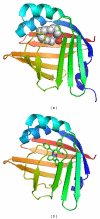Lipid chaperones and metabolic inflammation
- PMID: 22121495
- PMCID: PMC3206330
- DOI: 10.4061/2011/642612
Lipid chaperones and metabolic inflammation
Abstract
Over the past decade, a large body of evidence has emerged demonstrating an integration of metabolic and immune response pathways. It is now clear that obesity and associated disorders such as insulin resistance and type 2 diabetes are associated with a metabolically driven, low-grade, chronic inflammatory state, referred to as "metaflammation." Several inflammatory cytokines as well as lipids and metabolic stress pathways can activate metaflammation, which targets metabolically critical organs and tissues including adipocytes and macrophages to adversely affect systemic homeostasis. On the other hand, inside the cell, fatty acid-binding proteins (FABPs), a family of lipid chaperones, as well as endoplasmic reticulum (ER) stress, and reactive oxygen species derived from mitochondria play significant roles in promotion of metabolically triggered inflammation. Here, we discuss the molecular and cellular basis of the roles of FABPs, especially FABP4 and FABP5, in metaflammation and related diseases including obesity, diabetes, and atherosclerosis.
Figures


Similar articles
-
Fatty Acid-Binding Protein 4 in Cardiovascular and Metabolic Diseases.J Atheroscler Thromb. 2019 Mar 1;26(3):216-232. doi: 10.5551/jat.48710. Epub 2019 Feb 7. J Atheroscler Thromb. 2019. PMID: 30726793 Free PMC article. Review.
-
Endoplasmic reticulum stress and inflammation in obesity and diabetes.Circ Res. 2010 Sep 3;107(5):579-91. doi: 10.1161/CIRCRESAHA.110.225698. Circ Res. 2010. PMID: 20814028 Review.
-
Fatty Acid-Binding Protein 4 (FABP4): Pathophysiological Insights and Potent Clinical Biomarker of Metabolic and Cardiovascular Diseases.Clin Med Insights Cardiol. 2015 Feb 2;8(Suppl 3):23-33. doi: 10.4137/CMC.S17067. eCollection 2014. Clin Med Insights Cardiol. 2015. PMID: 25674026 Free PMC article. Review.
-
Adipocyte/macrophage fatty acid binding proteins in metabolic syndrome.Curr Atheroscler Rep. 2007 Sep;9(3):222-9. doi: 10.1007/s11883-007-0023-6. Curr Atheroscler Rep. 2007. PMID: 18241617 Review.
-
Targeting IRE1 with small molecules counteracts progression of atherosclerosis.Proc Natl Acad Sci U S A. 2017 Feb 21;114(8):E1395-E1404. doi: 10.1073/pnas.1621188114. Epub 2017 Jan 30. Proc Natl Acad Sci U S A. 2017. PMID: 28137856 Free PMC article.
Cited by
-
Increased Levels of Adipocyte and Epidermal Fatty Acid-Binding Proteins in Acute Lymphoblastic Leukemia Survivors.J Clin Med. 2021 Apr 8;10(8):1567. doi: 10.3390/jcm10081567. J Clin Med. 2021. PMID: 33917805 Free PMC article.
-
The application of transcriptomic data in the authentication of beef derived from contrasting production systems.BMC Genomics. 2016 Sep 21;17(1):746. doi: 10.1186/s12864-016-2851-7. BMC Genomics. 2016. PMID: 27654331 Free PMC article.
-
Fatty acid-binding protein 4 circulating levels in non-segmental vitiligo.An Bras Dermatol. 2022 Jan-Feb;97(1):28-36. doi: 10.1016/j.abd.2021.04.014. Epub 2021 Nov 25. An Bras Dermatol. 2022. PMID: 34839983 Free PMC article.
-
Elevation of circulating fatty acid-binding protein 4 is independently associated with left ventricular diastolic dysfunction in a general population.Cardiovasc Diabetol. 2014 Aug 21;13:126. doi: 10.1186/s12933-014-0126-7. Cardiovasc Diabetol. 2014. PMID: 25142635 Free PMC article.
-
Fatty acid binding protein 4 deficiency protects against oxygen-induced retinopathy in mice.PLoS One. 2014 May 6;9(5):e96253. doi: 10.1371/journal.pone.0096253. eCollection 2014. PLoS One. 2014. PMID: 24802082 Free PMC article.
References
-
- Larsen GL, Henson PM. Mediators of inflammation. Annual Review of Immunology. 1983;1:335–359. - PubMed
-
- Hotamisligil GS. Inflammation and metabolic disorders. Nature. 2006;444(7121):860–867. - PubMed
-
- Gregor MF, Hotamisligil GS. Inflammatory mechanisms in obesity. Annual Review of Immunology. 2011;29:415–445. - PubMed
-
- Hirosumi J, Tuncman G, Chang L, et al. A central, role for JNK in obesity and insulin resistance. Nature. 2002;420(6913):333–336. - PubMed
-
- Yuan M, Konstantopoulos N, Lee J, et al. Reversal of obesity- and diet-induced insulin resistance with salicylates or targeted disruption of Ikkβ . Science. 2001;293(5535):1673–1677. - PubMed
LinkOut - more resources
Full Text Sources
Other Literature Sources
Research Materials
Miscellaneous

